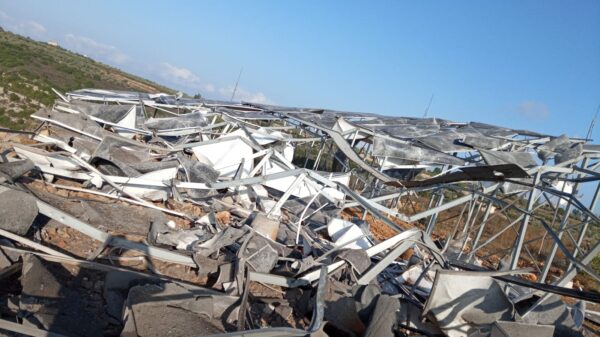Kassem Ghorayeb told pv magazine today that the panels and the control room comprising the Tair Harfa solar project were allegedly “bombed” by Israeli forces earlier this month. As it currently stands, the site, located on the outskirts of the Lebanese community which is 5 kilometers north of the Israeli border, is a reduced heap of scrap metal.
“I am now trying to think of ways to rebuild,” said Ghorayeb, an assistant professor at the American University of Beirut’s Chemical Engineering and Advanced Energy Department. “We cannot afford to fail. People are now being taken by fear because they are fearing for their lives.”
Ghorayeb, born and raised in Tair Harfa but now living in the country’s capital, conceived with some friends the idea to build a 100 kW solar array on the edge of the town in 2021. The project was driven by a need to provide Tair Harfa’s families – mostly farmers – with affordable water, Ghorayeb said.
“The [government] collapse that happened two or three years ago in Lebanon means we can no longer afford generators, especially poor people,” he said, referring to the 2019 Lebanese economic crisis which left many in poverty and without stable electricity. Villagers relied on hiring expensive diesel generators to pump water or purchased pricey water outright for their household needs, he said.
Seeing the need for cheap water, the project organizers hatched a plan to build a solar array that would power the plumbing. They raised roughly 80% of the project’s total $130,000 costs through community fundraising, with the final portion of funding borrowed on loan from a local business owner.
The solar array was finally switched on in September 2022. “People were happy,” Ghorayeb said, adding that the move was “unprecedented.” Residents used the water for general household needs and irrigated their small gardens, but it also revolutionized how the community accessed water and energy, he said.

Kassem Ghorayeb.
More than 400 of the village’s families paid roughly $3 per month to access the service, Ghorayeb said. The plant, located on the top of a hill, consisted of roughly 200, 540 W panels that harvested PV energy to pump water from a well 300 meters underground to the village. The array was operational from 8 am to 4 pm in the summertime, with a control room affixed to the site for monitoring.
But on Nov. 3, 2023, Israeli forces allegedly destroyed the power plant, Ghorayeb said.
“We spent a year building it but then it maybe took one second to be demolished,” he said. “There is no question that it was hit from the Israeli side.”
pv magazine sent inquiries to the Israeli press department asking whether it was behind the attack but did not get a response.
The Israeli army has reportedly used its warplanes to strike Hezbollah targets on the outskirts of Lebanon, Reuters reports.
The Tair Harfa solar site, located on the lip of the country's south, is currently a warped mountain of modules and metal. Alongside the project, Ghorayeb alleges “a couple” of community houses have been flattened due to the fighting. Some people have fled the village while others without the financial means to escape have remained, he said.
Ghorayeb has launched a subsequent GoFundMe campaign to try to raise another $130,000 to rebuild the solar array. He is aware, however, that as a war is being waged in Gaza many people may “not be thinking” about donating money to a Lebanese solar project.
“Only us who have been campaigning hard and patiently to gather the money are aware of the consequences,” he said. “The consequences are very dire here in terms of how are we going to rebuild.”
Luckily it is currently raining, Ghorayeb said, meaning residents can fill up their water-collecting drums and not rely on expensive water produced from diesel generators. But the weather may not always be so fortuitous. “It took one year at the beginning, last year, to build,” Ghorayeb said. “I am afraid it may take longer now.”

Kassem Ghorayeb.
This content is protected by copyright and may not be reused. If you want to cooperate with us and would like to reuse some of our content, please contact: editors@pv-magazine.com.



Good & interesting article. I totally agree with Dr Ghorayeb on the violence of Israel military that demolishes facilities just to put a pressure on lebanese people. I’d appreciate if you spoke a bit about technical schematics for water pumping using solar system and even pricing..
Tried to make a donation but GFM only accepts EU $$$ so no one it seems from USA can donate ?